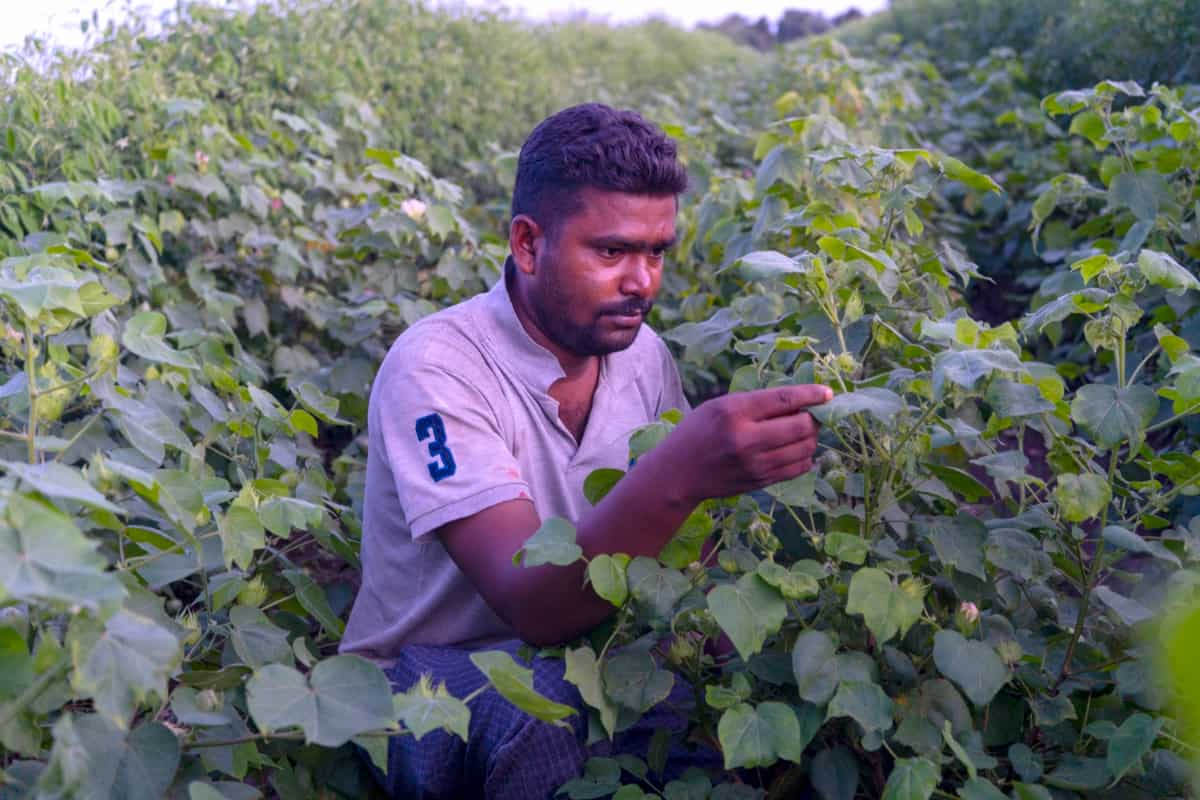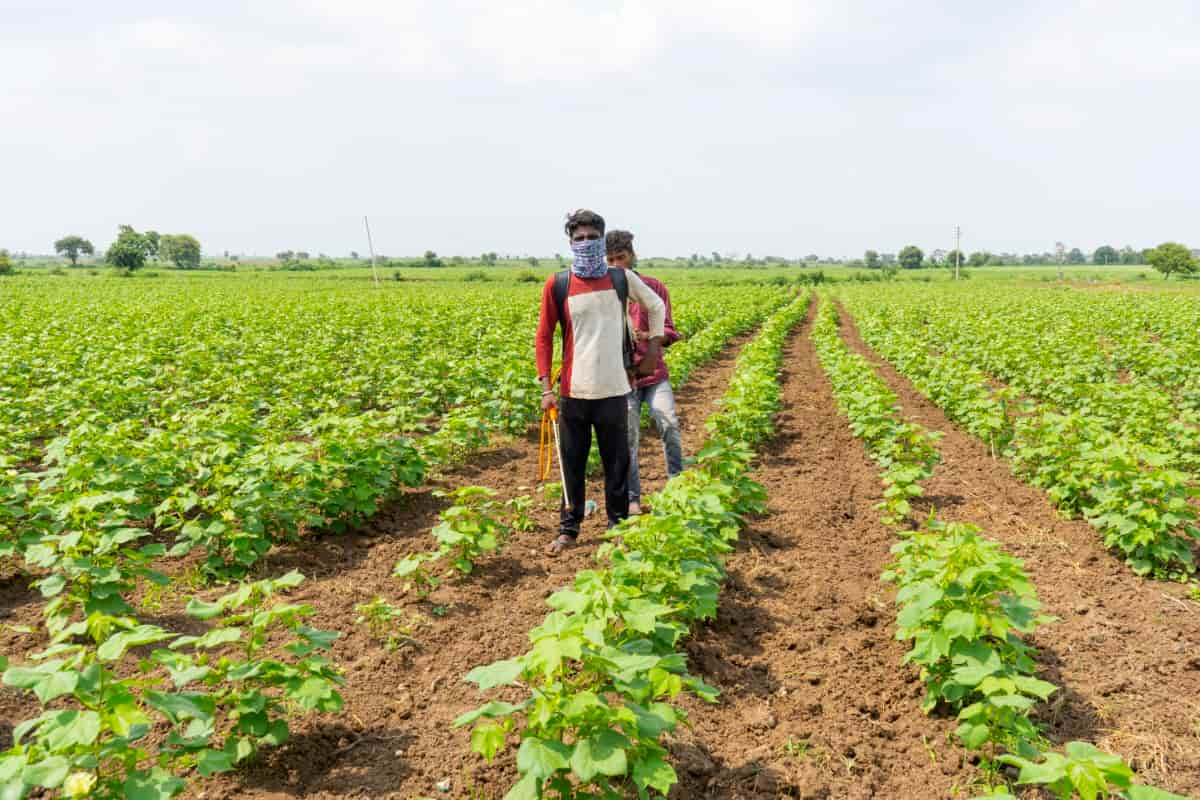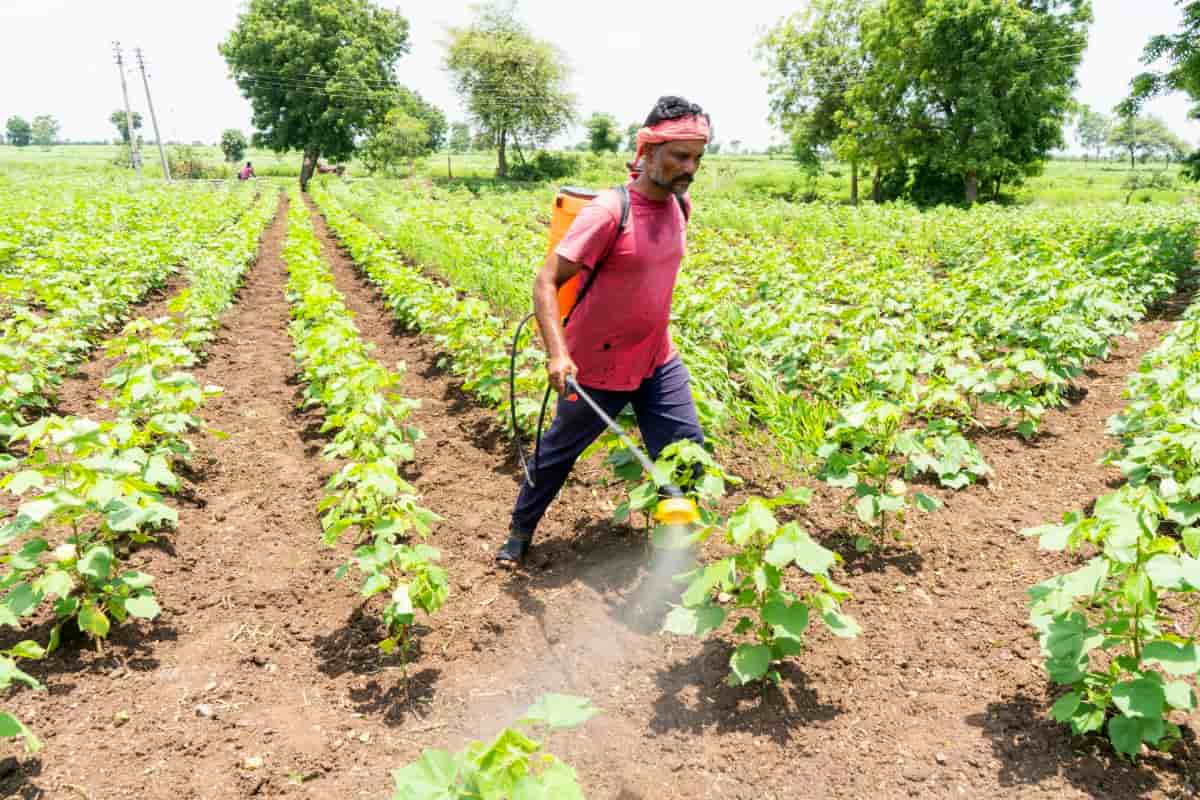Pink Bollworm Infestation in Bt-Cotton is a severe concern for cotton farmers around the world. Understanding this infestation is crucial to combat it and protect crop yields effectively. The Pink Bollworm is a destructive pest that primarily affects cotton crops. It feeds on the developing bolls, causing damage to both the quality and quantity of cotton production. This insect has become particularly problematic in regions where genetically modified Bt-Cotton varieties are grown.

Pink bollworm infestation in Bt-Cotton
Identify Symptoms of Pink Bollworm Infestation in Bt-Cotton
- Boll damage: Pink bollworm larvae feed on cotton squares and bolls, causing them to become discolored, shriveled, or rotten. Infested bolls may also have exit holes where mature larvae emerge.
- Frass presence: Look for tiny black or brown droppings called frass near damaged cotton squares and bolls. This is a clear indication of pink bollworm activity.
- Silk destruction: Pink bollworm larvae chew through the silk channels in cotton flowers, preventing pollination and reducing yield potential.
- Larval presence: Inspect plants closely for the presence of small pale green or pinkish caterpillars with dark heads inside damaged flowers or fruiting bodies.
- Plant stunting: Severe infestations can lead to plant stunting as resources are diverted towards combating the pests instead of growth and development.
Chemical Control Methods for Pink Bollworm in Bt-Cotton
Chemical control methods play a crucial role when it comes to combating pink bollworm infestation in Bt-cotton. These methods involve the use of insecticides specifically designed to target and eliminate these destructive pests. One commonly used insecticide for pink bollworm control is pyrethroid.
It is applied either as a foliar spray or through soil application. Pyrethroids work by interfering with the nervous system of insects, causing paralysis and ultimately leading to their death. Another option is endosulfan, which acts on the pink bollworm’s central nervous system and disrupts its normal functioning. This insecticide can also be applied using foliar sprays or incorporated into the soil before planting.
Integrated Pest Management for Pink Bollworm in Bt-Cotton
Integrated Pest Management is a holistic approach to managing pest problems in agriculture, and it plays a crucial role in combating pink bollworm infestation in Bt-Cotton. This method focuses on using multiple strategies to control pests. One key aspect of Integrated Pest Management is cultural practices. By rotating crops, farmers can disrupt the life cycle of pink bollworms and reduce their population.
Additionally, planting Bt-Cotton varieties that are resistant to pink bollworms can significantly decrease the risk of infestation. Another component of Integrated Pest Management is biological control. This involves introducing natural enemies of the pink bollworm, such as parasitic wasps or predatory beetles, into the cotton fields. These beneficial insects help keep the population of pink bollworm under control without relying solely on chemical pesticides.
Furthermore, monitoring plays a vital role in Integrated Pest Management for pink bollworm management. Regular inspections should be conducted to detect early signs of infestation so that appropriate actions can be taken promptly. Monitoring methods may include pheromone traps or visual inspections for eggs or larvae.
In case you missed it: How to Create a Low-Maintenance Cottage Garden in 10 Steps: Budget-Friendly Tips

Economic Impact of Pink Bollworm Infestation in Bt-Cotton
The economic impact of pink bollworm infestation in Bt-cotton is a significant concern for farmers and the cotton industry. This devastating pest not only reduces crop yields but also increases production costs, leading to financial losses. When pink bollworm larvae feed on cotton bolls, they cause damage by feeding on the seeds, reducing their quality and yield potential.
As a result, farmers experience reduced profits due to lower yields and decreased market value for their cotton. In addition to direct yield losses, controlling pink bollworm infestation requires additional expenses. Farmers have to invest in insecticides and other chemical control methods to manage the pest population. These costs can be substantial and can further strain the already tight budgets of cotton growers.
Moreover, when pests like pink bollworm become resistant to certain insecticides over time, farmers may need more expensive or alternative control measures that can significantly increase production costs. The economic impact extends beyond individual farms as well. Pink bollworm infestations can affect entire regions or even countries with large-scale cotton production. This leads to reduced competitiveness in global markets and loss of revenue for these economies heavily reliant on cotton exports.
Biological Control of Pink Bollworm in Bt-Cotton
Biological control is a sustainable and eco-friendly approach to managing pink bollworm infestation in Bt-Cotton. It involves the use of natural enemies such as predators, parasitoids, and pathogens to suppress pest populations. These beneficial organisms play a crucial role in regulating the population of pink bollworms, reducing their damage to cotton crops. One effective biological control method is the release of Trichogramma wasps, which are natural enemies of pink bollworm eggs.
Another biological control agent is Bacillus thuringiensis (Bt), a soil bacterium that produces toxic proteins harmful only to specific pests like pink bollworms. Bt-based biopesticides can be sprayed on cotton plants or incorporated into genetically modified Bt-Cotton seeds. In addition to these methods, cultural practices such as crop rotation and maintaining plant diversity can also enhance biological control by attracting beneficial insects that prey on pink bollworms.
Monitoring and Detection of Pink Bollworm Infestation in Bt-Cotton
Monitoring and detecting pink bollworm infestation in Bt-cotton is crucial for effective pest management. By regularly monitoring the cotton fields, farmers can identify early signs of infestation and take necessary action to minimize damage. One method of detection is using pheromone traps. By counting the number of moths caught in the trap, farmers can estimate population levels and determine if intervention is required.
In case you missed it: Natural and Organic Ways to Treat Cotton Leaf Curl: Fix with Effective Home Remedies

Another approach involves visual inspection of plants and bolls for characteristic symptoms such as entry/exit holes, frass (insect waste), webbing, or damaged squares and bolls. This helps identify areas where pink bollworm larvae may be present. Furthermore, regular field scouting by trained personnel allows for a more comprehensive assessment of infestation levels. They can visually inspect plants at different growth stages to pinpoint hotspots within the field.
Resistance Management Strategies for Pink Bollworm in Bt-Cotton
Refuge Planting: The use of non-Bt cotton plants as a refuge within or near the Bt-cotton fields is essential. This provides a habitat for susceptible pink bollworms, ensuring their survival and reducing selection pressure on the resistant individuals.
Rotation of Modes of Action: It is important to rotate different modes of action when using chemical insecticides to control pink bollworms. By alternating between other classes of pesticides, you can minimize the chances of developing resistance.
Monitoring and Early Detection: Regular monitoring and early detection play a vital role in managing pink bollworm resistance. By closely monitoring pest populations, farmers can identify any signs of decreased susceptibility and take immediate action.
Awareness and Education: Educating farmers about proper insecticide usage techniques, implementing recommended best practices, and promoting awareness about resistance management are crucial steps toward sustainable pest control.
Environmental Impact of Chemical Control on Pink Bollworm in Bt-Cotton
Chemical control methods are often employed to control pink bollworm infestation in Bt-cotton. While chemical control can effectively reduce pink bollworm populations and protect cotton crops, it also has potential drawbacks. One major concern is the use of synthetic insecticides, which can have adverse effects on non-target organisms and disrupt natural ecosystems. These chemicals may harm beneficial insects such as bees and natural predators that help keep pest populations in check.
In case you missed it: How to Grow Organic Cotton: Best Cultivation Practices

Moreover, repeated application of insecticides can lead to the development of resistance in pink bollworms. This means that over time, higher doses or different types of chemicals may be needed to achieve effective control. Another aspect to consider is the persistence of these chemicals in the environment. Some insecticides can persist for extended periods in soil and water systems, potentially causing contamination and harming other organisms downstream or through leaching into groundwater sources.
Conclusion
Proper management is crucial in combating pink bollworm infestation in Bt-cotton. This destructive pest can cause significant damage to cotton crops, leading to decreased yields and economic losses for farmers. By understanding the identification and symptoms of pink bollworms implementing effective chemical and biological control methods, you can minimize the impact of this pest on Bt-cotton.
- Feed Your Flock for Less: Top 10 Tips to Save on Chicken Feed
- Ultimate Guide to Ossabaw Island Hog: Breeding, Raising, Diet, and Care
- Hatching Answers: The Top 10 Reasons Your Chickens Aren’t Laying Eggs
- Eggs and Economics: Breaking Down the Cost of Raising Backyard Chickens
- Defend Your Greens: Proven Methods to Keep Iguanas Out of Your Garden
- Ultimate Guide to Cinnamon Queen Chicken: A Comprehensive Guide for Beginners
- Ultimate Guide to California Tan Chicken: Breeding, Raising, Diet, Egg-Production and Care
- Ultimate Guide to Marsh Daisy Chicken: Breeding, Raising, Diet, and Care
- 10 Types of Chicken Farming Businesses You Can Start for Profits